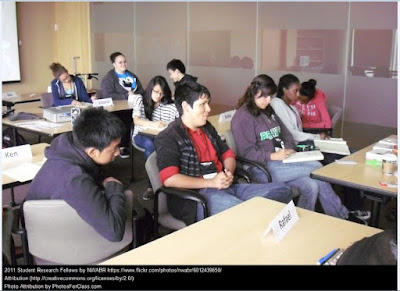If we really took the time to ask students what they
would change about school, every kid would have something to say. At the
elementary level I am sure you would get a lot of responses about more recess
time, better lunches, and more time to play. At the middle school level, kids
want more freedom to choose classes and activities, more time with friends, and
probably “recess”. High school students again want freedom of choice in classes
that are available and when they are held, later start times, and opportunities
to make decisions that will positively affect their futures and prepare them for “life”.
Here are some actual responses when teens were asked what they would change about high school from The Huffington Post Teens:
Here are some actual responses when teens were asked what they would change about high school from The Huffington Post Teens:
20 Teens Share What They Would Change About High School: The Huffington Post
However, when we ask students about their opinions on classroom instruction, specifically the role of creativity in the classroom, this is a much harder question for them to answer. Students have become so ingrained in traditional educational practices, especially by the time they are older (middle and high school) they have difficulty envisioning how education might look different, even in small ways. Kelly Christopherson presented this problem to his 12th grade Social class asking them how they might change the model of school. Their answers were surprising in that they offered ideas more for the environment of school rather than the structure. See the article here: Do Students Want to Transform School?
So what do students currently value about creativity in
the classroom? What would students
change about how technology is used to support creativity in the classroom? I
asked this question of a former student who is now in high school. She too, had
difficulty answering this question. She feels that using digital tools to
support creativity is helpful to students because when they can create something
it is more interesting and therefore students put more effort into the
activity. She also feels like she gets more out of those activities that just
listening to the teacher talk while the class takes notes. As for what she
would change, this posed a difficult question for her to answer because it was
hard for her to see the possibilities of what could be different.
After some ideas, she thought that increasing the number
of projects and activities that involve creating some type of product would be
one suggestion she would make. She also thought becoming more familiar with
available web tools that allowed students to complete assignments in new ways,
rather than having traditional worksheets and writing papers would be helpful.
She also suggested having more exploration learning (my term for her
description) where students are given the resources to gather information but
are responsible for the actual learning, rather than traditional “lecture-take
notes” instruction. Finally, she advocated for the use of groups and partners
in classroom instruction and activities so the students could work together and
learn to build off of each other, rather than learn in isolation.
The suggestions made by this student are not radical or
earth shattering. In fact, I would call them good teaching practices. However,
many of these practices are still foreign to the teachers in charge of our
classrooms today. I believe that things are slowly changing. As more and more
of our teachers come into the classroom with the understanding of the role
creativity plays in effective instruction and how digital media and technology
can support creativity, we are seeing changes in the classroom. It is a slow
change, to be sure. In fact, in her article “Why
Kids Need Schools to Change” Tina Barseghian cites Madeline Levine who
describes this change. “I’m
astounded at the glacial pace of change in education. Like many academic areas,
there’s a huge disconnect between what’s known and what’s in practice. It’s
very slow moving” (Levine, 2012). We know the changes that need to be
made, and so do our students. The issue seems to be getting the changes to
happen. Our educational system needs to realize that we don’t need to explore what the changes need to be, but rather
how to actually get these changes in
the classroom.
Most teachers know our
traditional methods of instruction are no longer sufficient for the students in
our classrooms. There are some teachers that are resistant to the
implementation of student-directed classrooms in favor of the traditional “sit
and get” method, but I believe these teachers are in the minority. However,
those teachers that want to change how they teach are limited by availability
of resources, access to technology, understanding of how to use digital tools,
or pressure to get students to perform on standardized tests. It is these
barriers that must be addressed and overcome to truly change classroom
instruction for the benefit of our students. Still, if we are to truly give our
students the tools they need to be prepared beyond their school career, this is
a job at which we must succeed.
Barseghian, Tina. (2012). Why kids need schools to change. Retrieved July 25, 2015 from http://ww2.kqed.org/mindshift/2012/09/21/why-kids-need-schools-to-change/ .
Huffington Post. (2014) 20 Teens share what they would change about high school. Retrieved July 25, 2012 from http://www.huffingtonpost.com/2014/02/24/high-school-changes_n_4844338.html .
Levine, Madeline. (2012). Teach your children well. New York, New York: Harper Collins Publishers.
Levine, Madeline. (2012). Teach your children well. New York, New York: Harper Collins Publishers.







No comments:
Post a Comment